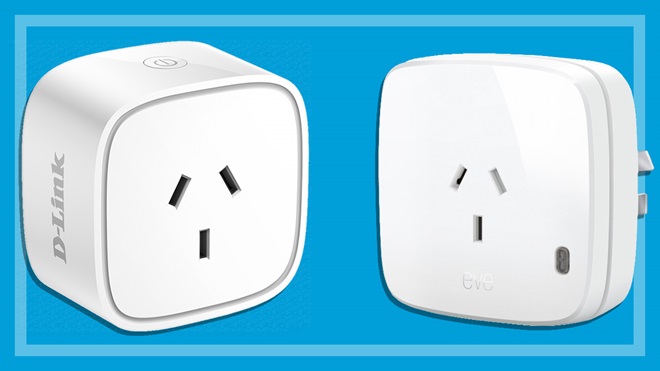CHOICE verdict
These two new smart plugs let you turn any mains-powered household device into a so-called smart device, letting you turn it on and off remotely via a smartphone app, even if you're far away from home. They work via app or voice control through smart speakers. Both devices let you add more similar units as your needs grow, along with related products, and are a relatively easy way to started with DIY home automation.
Price: D-Link $40. Eve Energy $85
We tried out two new smart plug devices, courtesy of Eve Energy and D-Link, to see how they can help automate your home.
- D-Link's entry is the DSP-W118 mydlink Mini Wi-Fi Smart Plug, which gives you on-off control, plus scheduling and timer capabilities. It works with iOS and Android phones.
- The Eve Energy Smart Plug offers similar automation features and can also help you manage running costs by monitoring your electricity usage for the connected device. But it's for Apple users only.
D-Link Mini Wi-Fi Smart Plug
As well as on-off control, the D-Link DSP-W118 mydlink Mini Wi-Fi Smart Plug has schedule and timer controls for automatic and unattended operation and is designed to work with automation services Google Assistant, Alexa, and IFTTT. An easily visible LED on top shows the on/off status at a glance. It's compact (6cm wide and deep) but may still impede some adjacent plugs. The load must not exceed 2400W (240V, 10A).
We initially had some issues installing this plug using two different Samsung Galaxy phones, but it went fine with a Google Pixel 3 phone. You first need the mydlink app and must create an account for the mydlink service, if you don't have one already for other D-Link devices. Your plug is added either manually or by scanning the provided QR code. It then steps you through connecting to your home Wi-Fi network.
Setting up the rules can take a little trial and error, but they give you the convenience of one-touch control of multiple devices
As well as basic timers and schedules, there are some automation rules you can apply, which work with other D-Link smart devices. We found that setting up the rules can take a little trial and error, but they give you the convenience of one-touch control of multiple devices.
With multiple D-Link products present, the rules can be more elaborate. For example, if you have an internet-based security camera, a rule can be set to switch on the Smart Plug whenever motion or sound events are detected. This example lets you use it as a sensor light if a lamp is plugged in.
At the time of testing, we had some issues at first getting Google Home to link to the mydlink app (an app update was needed), but the plug worked fine with Alexa straight out of the box. It should be noted that with this sort of product, occasional app updates can be expected, but are generally worth doing, as they may add new features and better security.
Eve Energy Smart Plug
The $85 Eve Energy Smart Plug puts emphasis on control of running costs, as well as devices. It gives you remote control, but also lets you track the electricity usage of the connected device.
Coming from the stable of Elgato products, it's designed for Apple HomeKit devices only. It works well via Apple's Home app, which comes standard on iPhones, and you can use a HomePod speaker or Apple TV as a hub for centralised control. To get started, you download the Elgato Eve app and use it to install the Eve Energy plug, using its Homekit number.
The built-in power meter is its standout feature
This plug is a bit larger (7.5cm wide and deep) and will impede adjacent outlets. It has a rating of 1840W (220V, 8A), which is less load than the D-Link Mini Wi-Fi Smart Plug can handle. It has a physical on/off switch as well.
The built-in power meter is its standout feature. It reports voltage and amperage and when run for long enough can give you projections of energy consumption and cost. The default cost for electricity used for these calculations is 33 cents per kilowatt hour, so this will need to be changed from the settings to reflect your supplier's rate.
You can obtain a breakdown of energy consumption by room and time of day, and you can see a graph showing hourly, daily, weekly, or monthly usage. Rules can be set to govern the switch, with triggers such as sunrise and sunset, time of day and location data. You can also set timers and there are some built-in scenes (action combinations) to which you must assign actions.
It takes a bit of playing around with all of these features to understand what you can do, but that reflects the device's versatility.
Eve Energy has various other connected home devices, including the Eve Aqua, a ($180) smart water controller that lets you water your garden remotely and monitor your water usage using your smart phone.
We're on your side
For more than 60 years, we've been making a difference for Australian consumers. In that time, we've never taken ads or sponsorship.
Instead we're funded by members who value expert reviews and independent product testing.
With no self-interest behind our advice, you don't just buy smarter, you get the answers that you need.
You know without hesitation what's safe for you and your family.
And you'll never be alone when something goes wrong or a business treats you unfairly.
Learn more about CHOICE membership today
Stock images: Getty, unless otherwise stated.



